ChitonBurmese


Chitons, in Burmese folklore, are malevolent spirits believed to cause harm and misfortune to individuals and communities. These spirits, rooted deeply in the rich tapestry of Burmese supernatural beliefs, have been a part of the country's cultural heritage for centuries. They are often depicted in traditional Burmese literature, art, and oral stories, reflecting the local customs and societal fears.
The concept of chitons originates from ancient Burmese animistic beliefs, which predate the introduction of Buddhism. These beliefs revolve around the idea that spirits, both good and evil, inhabit the natural world. Chitons are thought to be vengeful spirits of people who suffered unjust deaths or those who died with strong, unfulfilled desires. They are often characterized by their malevolent intentions, seeking to cause harm to the living either out of vengeance or mere malevolence.
Chitons are typically described as having a terrifying appearance, often portrayed as grotesque or distorted figures in art and literature. They may appear as ghostly apparitions or take on more tangible, monstrous forms. These spirits are believed to possess various supernatural abilities, such as the power to possess individuals, bring about illnesses, or manipulate natural elements to create disasters.
In Burmese culture, chitons hold a significant place in the collective consciousness. They are not just mere figures of folklore; they embody the fears and anxieties of the people. Stories and cautionary tales about chitons serve as moral lessons, warning against unjust actions that might incur the wrath of these vengeful spirits. Rituals and amulets are often used in Burmese culture to ward off chitons and protect against their malevolence.
In contemporary times, the belief in chitons has waned but not disappeared. They remain a part of the cultural heritage, influencing modern media and entertainment. Films, books, and television shows sometimes feature chitons, adapting the ancient beliefs to fit contemporary narratives. These modern interpretations often explore deeper psychological and societal themes, using the chitons as metaphors for human fears and societal ills.
The chiton, as an evil spirit in Burmese folklore, offers a fascinating glimpse into the cultural and spiritual beliefs of Myanmar. It reflects the complexities of human emotions, the fear of the unknown, and the consequences of moral transgressions. As Myanmar continues to evolve, the legacy of the chiton remains a testament to the rich and diverse tapestry of its cultural history.
Demons



